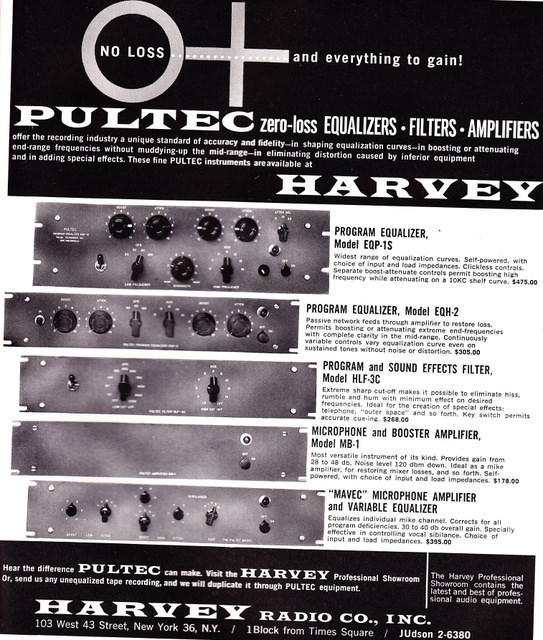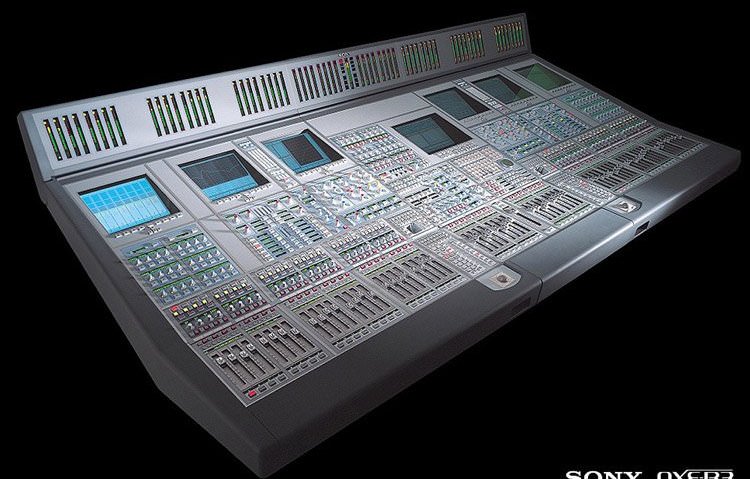Pultec EQP-1A
 The Pultec is the oldest model on our list, but six decades into its career it remains as relevant as ever. Introduced (as the EQP-1A) in 1951, the Pultec is about as classic as classic audio gear gets, used on countless recordings in every genre. You can see the influence of its design and sound in modern options like the the Tube-Tech EQ 1A, the Summit Audio EQP-200B and, of course, the Manley EQP-1A and Massive Passive, but no matter how many engineers try to update and upgrade the concept, there’s something about the original which remains timeless.
The Pultec is the oldest model on our list, but six decades into its career it remains as relevant as ever. Introduced (as the EQP-1A) in 1951, the Pultec is about as classic as classic audio gear gets, used on countless recordings in every genre. You can see the influence of its design and sound in modern options like the the Tube-Tech EQ 1A, the Summit Audio EQP-200B and, of course, the Manley EQP-1A and Massive Passive, but no matter how many engineers try to update and upgrade the concept, there’s something about the original which remains timeless.
Incredibly smooth, musical and absolutely full of character, Pultecs sound good on pretty much anything. They’re industry standard for vocals, but sound just as good on kick drums. With just four choices for the low-frequency shelf filter, seven for the high-frequency peak boost and three for the high-frequency shelf, the Pultec specialises in broad brushstrokes rather than precise surgical shaping. Then there’s the classic trick whereby you boost and cut simultaneously with the low-frequency filter, creating an altogether different shape of curve.
Chopstick, who has a pair of Pultecs, can’t speak highly enough of them. “It’s definitely not made for any precise surgical EQing,” he explains, “but the gentle equalisation curves make it so damn musical. You can get really interesting results and it always sounds musical. Even though there’s so little to play around with compared to fully parametric EQs, the results speak for themselves. It’s my go-to for vocals. If you have a vocal, insert the EQP-1A and play around with it. And if you don’t have a vocal, use it on your kick drum. The beauty is that you can boost and attenuate simultaneously – you’ll get that punch you need in your bottom end.”
It always sounds musical... The results speak for themselves.
The Pultec EQP-1A and the later 1A3 employ a valve gain stage after the filters in order to bring the signal back up to its original level (passive filtering results in an unavoidable drop in signal level). It’s this combination of passive filter circuits, valve gain stage and transformers which give the Pultec its much sought-after sound. Some modern interpretations also incorporate features of related models such as the EQ-H2 high-frequency equaliser and MEQ-5 mid-band equaliser.
In addition to the dozens of hardware EQs inspired by the Pultec, you can also take your pick from countless software emulations. Try Universal Audio, Waves, Nomad and IK Multimedia for a start. Whichever one you go for – software or hardware – we don’t think you’ll be disappointed.

08.29 PM
I love you all.
08.53 PM
You missed KUSH! for higher, simply the best.
08.55 PM
PS I dot think you acknowledged that precision cuts are a different ballgame to those beautiful wide sweeps. Different tool.s.
09.00 PM
for me, Pultec for bass. Cambridge for tight cuts. and natives for gentleness. If that makes sense. Either way, keep up the good work.
09.29 PM
Maag?
03.01 AM
The most important Eq curve for dance music is the 24 or preferably 48 dB/Oct slope highpass filter. It allows producers with even average abilities to create low end and low mids that are complex and layered yet intelligible. Most producers I know have an Eq doing just this on good percentage of the tracks in every song. I’d say that for and EQ to truly be the EQ of dance music it would need to be able to not only do this but be available to do it on 10 or more (usually more) stereo tracks at the same time. This is where the humble native EQ in most daws shines with its low DSP rent high flexibility. It might not be the most glamorous or best sounding EQ but it might do more for the bass than even a pair of hardware pultec or even a gaggle of dsp pultecs. Add in its pre and post internal spectrum analyzer and it seems pretty amazing.
04.25 PM
I Love the IK Pulteq, it just makes most things sound better. Too easy to get carried away with it though.
06.48 PM
Just some notes on availability of these EQs as emulations. Both the API 500 series and Sonnox Oxford have officially licenced plug-in versions from Universal Audio.
http://www.uaudio.com/store/equalizers/api-500-series-eq-collection.html
http://www.uaudio.com/store/equalizers/oxford-eq.html
04.14 AM
KEEP up the phenomenal work guys!
10.16 AM
I own a clariphonic myself, and I don’t think there’s a better eq to focus and lift the highs on your 2-buss. Personally, I’m getting ready to sell my SSL E-series EQs so that I can pickup an Electra from Kush…
He’s doing it right.
11.59 AM
Awesome magazne with loads of very useful tricks and insights for the general producing general producers that just don’t have the means to approach music with real world professional knowledge. Very grateful and wish you a continuesly sucessful and quality ensured publication of such! 100% support :)
06.41 PM
Um how there is no baxendall eq here is just beyond me. The most used and useful eq of all time. Didn’t get a look in.
02.54 AM
Kush isn’t a secret anymore, the word is out. The best, most intuitive and creative EQ and Compressor I’ve ever used. Slow to upgrade completely to AAX, but worth the wait.
01.10 PM
Oh .. I love SSL EQ man ! its the amazing shit u can ever get 😀
12.54 AM
what about the millennia NSEQ-2, the GML 8200 and Maselec Mea 2 ? (there’s also the Crane IBIS)
06.12 AM
That mackie EQ is fucking shite, I can’t believe you put that next to the SSL, which is the mutt’s nuts.
02.00 AM
I use the 5500 in my mastering rig everyday. It’s stellar for fast program, passes every transient perfectly. Big bold sound. Not what I would call transparent but perfect for electronic music.
Will Brodeur
lacquer channel mastering.
10.33 PM
Elysia Xpressor is one notable absence from this list… the Elysia stuff is practically made for electronic music, so clean and precise.
06.03 AM
So why you not tell anything about NEVE EQ’s?